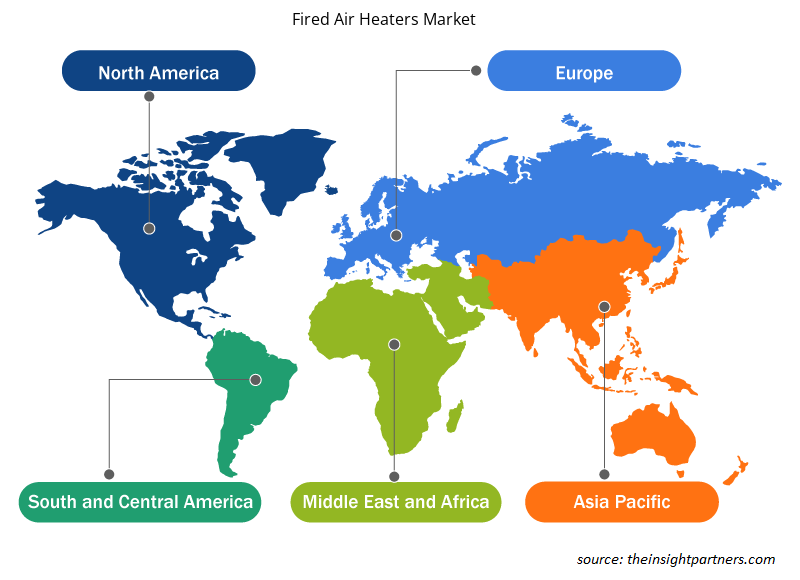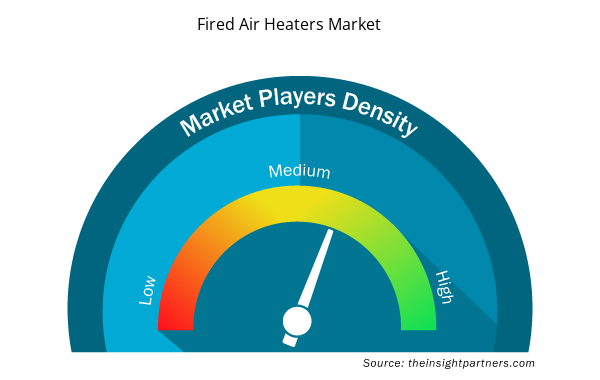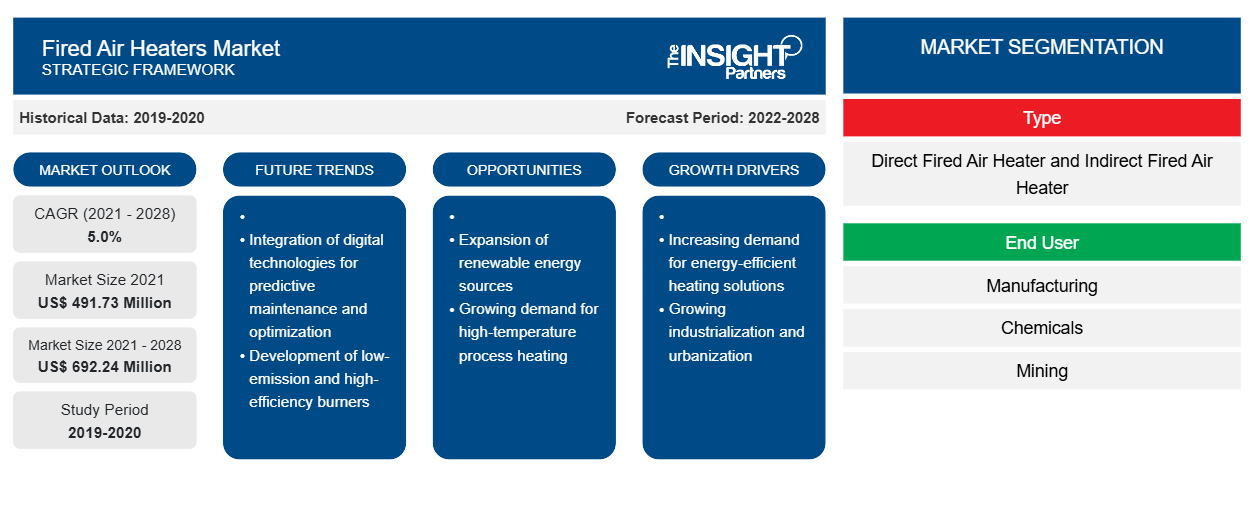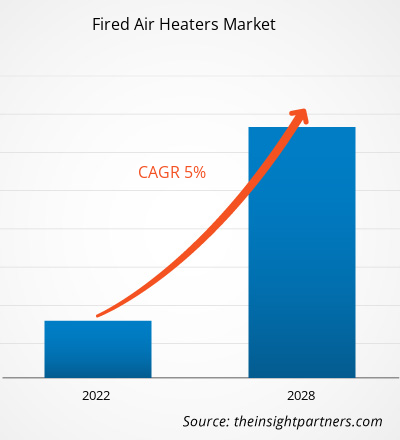من المتوقع أن ينمو سوق سخانات الهواء من 491.73 مليون دولار أمريكي في عام 2021 إلى 692.24 مليون دولار أمريكي بحلول عام 2028؛ ومن المتوقع أن ينمو بمعدل نمو سنوي مركب قدره 5.0٪ من عام 2021 إلى عام 2028.
إن ارتفاع الطلب على معدات التدفئة للتطبيقات الصناعية في البلدان الناشئة هو القوة الدافعة الرئيسية لسوق سخانات الهواء المحروقة . إن الحاجة إلى سخانات الهواء المحروقة مدفوعة بالطلب المتزايد على الطاقة من الشركات في الاقتصادات الناشئة مثل الصين والهند واليابان والبرازيل. وعلاوة على ذلك، نظرًا لقصر وقت البدء والكفاءة العالية والموثوقية، فقد زاد الطلب على سخانات الهواء المحروقة في التصنيع وتوليد الطاقة والمعالجة. بالإضافة إلى ذلك، فإن زيادة الاستثمار في قدرة توليد الطاقة هي عامل دافع آخر لسخانات الهواء المحروقة. وبسبب عقود من التطورات في تكنولوجيا إنتاج المنتجات، فإن الحاجة إلى سخانات الهواء المحروقة تستمر في التوسع بشكل كبير.
تُستخدم سخانات الهواء المحروق عادةً في صناعة المعالجة لتسخين الغازات أو السوائل إلى درجة حرارة معينة. وعلاوة على ذلك، فإن دمج إنترنت الأشياء (IoT) في سخانات الهواء المحروقة من شأنه أن يزيد من اعتماد سخانات الهواء المحروقة، مما يؤدي إلى نمو السوق خلال فترة التنبؤ.
قم بتخصيص هذا التقرير ليناسب متطلباتك
ستحصل على تخصيص لأي تقرير - مجانًا - بما في ذلك أجزاء من هذا التقرير، أو تحليل على مستوى الدولة، وحزمة بيانات Excel، بالإضافة إلى الاستفادة من العروض والخصومات الرائعة للشركات الناشئة والجامعات
- احصل على أهم اتجاهات السوق الرئيسية لهذا التقرير.ستتضمن هذه العينة المجانية تحليلاً للبيانات، بدءًا من اتجاهات السوق وحتى التقديرات والتوقعات.
تأثير جائحة كوفيد-19 على سوق سخانات الهواء الساخن
لقد أثر جائحة كوفيد-19 بشكل كبير على العالم ويستمر في تحطيم العديد من البلدان. حتى اندلاع كوفيد-19، كانت صناعة سخانات الهواء المحروق تشهد نموًا كبيرًا من حيث الإنتاج. لسوء الحظ، أدى تفشي كوفيد-19 إلى تقليص الطلب على سخانات الهواء المحروق عبر مختلف الصناعات على مستوى العالم، مما يعكس انخفاضًا كبيرًا في أحجام الطلبات بين مصنعي الطائرات، مما أدى إلى انخفاض عدد الإنتاج. أثر انخفاض أحجام الإنتاج سلبًا على أعمال مختلف مصنعي المكونات والتقنيات المرتبطة بها. علاوة على ذلك، أدى ضعف المستخدمين النهائيين مثل صناعات البناء والسيارات والتعدين إلى تثبيط السوق. وبالتالي، تأثرت أعمال اللاعبين في سوق سخانات الهواء المحروق بشدة بسبب عدم الاستقرار في الإنتاج. أثناء انتشار فيروس كوفيد-19 على نطاق واسع، توقفت صناعة البناء بأكملها مع الحد الأدنى من الموارد لتوقع المستقبل. تم إيقاف العديد من وحدات الإنتاج في الولايات المتحدة وفرنسا وروسيا والصين مؤقتًا للالتزام بقواعد الحكومة فيما يتعلق بالإغلاق والتباعد الجسدي. شهد لاعبو البناء انخفاضًا بنسبة 20-30٪ في الطلب على المشاريع الجديدة. بالإضافة إلى ذلك، أدى توقف مشاريع البناء الجارية إلى إضعاف السوق بشكل أكبر. وقد أثر هذا العامل سلبًا على سوق سخانات الهواء الساخن.
رؤى حول سوق سخانات الهواء الساخن
ارتفاع الطلب على معدات التدفئة للتطبيقات الصناعية
الغلايات والمضخات الحرارية والأفران هي معدات تدفئة صناعية تستخدم في الصناعات الكيميائية والغذائية والبناء والتعدين وغيرها من الصناعات لتنفيذ عمليات الإنتاج. الغلاية عبارة عن وعاء مغلق يتم فيه تسخين الماء أو سائل آخر ويتكون البخار، والذي يستخدم لاحقًا لتشغيل الآلات عند توزيعه تحت ضغط مرتفع. علاوة على ذلك، فإن مضخة الحرارة هي جهاز ينقل الحرارة إلى مناطق دافئة أو باردة. علاوة على ذلك، تعد الأفران مكونات أساسية لنظام التدفئة المركزية. في غلايات إعادة التسخين بالأمين والجليكول، يجب إزالة غازات كبريتيد الهيدروجين وثاني أكسيد الكربون المسببة للتآكل من بخار الهيدروكربون قبل تخزين الوقود المعني أو إدخاله في خط الأنابيب في تكرير الغاز الطبيعي والنفط الخام. على غرار بخار الغاز الطبيعي، يستخدم الجليكول لإزالة الماء من الغاز الطبيعي قبل التوزيع. نظرًا لصيانته الرخيصة وبساطته، يتم استخدام هذا النوع من السخانات في قطاعات الغاز الطبيعي والنفط الخام والمعالجة. في قطاع العمليات الكيميائية، تُستخدم السخانات المحروقة عادةً لتسخين سوائل المعالجة وتوليد البخار.
في أغلب الحالات، تستهلك السخانات التي تعمل بالحرق معظم الطاقة في صناعة العمليات. يتم استخدام سخان على شكل صندوق مع أنابيب رأسية لتسخين سائل هيدروكربوني لهذا البحث. تُستخدم سخانات الإيلوشن، وهو تطبيق متخصص لسخانات الهواء التي تعمل بالحرق والتي تتطلب تصميمًا مميزًا وفريدًا، في صناعة التعدين. الإيلوشن هو عملية استخراج مادة من أخرى عن طريق الغسيل بمذيب، دائمًا تقريبًا مع إضافة الحرارة، في الكيمياء التحليلية والعضوية. يتم استخراج المعادن مثل الذهب باستخدام المبادلات. يدور محلول المعدن والمذيب على جانب واحد من المبادل وينتشر سائل ناقل للحرارة - عادة سائل حراري - على الجانب الآخر. في صناعة الأغذية، وخاصة في قطارات القلي - البطاطس والوجبات الخفيفة والمطبوخة مسبقًا - يتم ذلك عن طريق سخانات سائل نقل الحرارة، حيث يدور السائل الحراري الذي يتم تسخينه في المعدات، وتنتقل حرارته إلى الزيت الذي يقلي المنتجات أعلاه من خلال التبادل. تم تنفيذ بعض التركيبات هنا، على غرار عملية الإيلوشن التعديني، حيث يدور زيت القلي مباشرة عبر المرجل، والذي يستخدم لاحقًا كسخان هواء محترق. تُستخدم السخانات ذات الحرق المباشر أحيانًا كسخانات سائل نقل الحرارة أو سخانات غير مباشرة في صناعة البتروكيماويات. إن التشغيل الجيد لخدمة صيانة السخانات ذات الحرق المباشر في المصانع الكيماوية ومصافي التكرير وتوحيد قطع الغيار هي الأسباب الرئيسية لهذا الاستيعاب لأن سخانات سائل نقل الحرارة مشهورة بمزاياها في وظائفها المحددة. وبالتالي، فإن ارتفاع الطلب على معدات التدفئة للتطبيقات الصناعية المختلفة يقود سوق السخانات ذات الحرق المباشر.
رؤى السوق القائمة على النوع
بناءً على النوع، تم تقسيم سوق سخانات الهواء إلى سخانات هواء مباشرة وسخانات هواء غير مباشرة. توفر السخانات المباشرة وسيلة آمنة لتدفئة البيئات الصناعية من خلال الحفاظ على نسبة مناسبة من الهواء إلى الوقود، سواء كان غازًا طبيعيًا أو بروبانًا. يتم توصيل الغاز مباشرة إلى الموقد في سخان مباشر، بينما يوفر تيار الهواء الأكسجين اللازم للاحتراق. يختلط الغاز بالهواء الذي يتم دفعه عبر حاجز الموقد. يتم إعداد الموقد للاحتراق جنبًا إلى جنب وبالتوازي مع تدفق الهواء. يتم خفض استهلاك الوقود ونفقات التشغيل حيث يتم تحويل ما يقرب من 100٪ من الوقود إلى حرارة.
رؤى إقليمية حول سوق سخانات الهواء الساخن
لقد قام المحللون في Insight Partners بشرح الاتجاهات والعوامل الإقليمية المؤثرة على سوق سخانات الهواء الساخن طوال فترة التوقعات بشكل شامل. يناقش هذا القسم أيضًا قطاعات سوق سخانات الهواء الساخن والجغرافيا في جميع أنحاء أمريكا الشمالية وأوروبا ومنطقة آسيا والمحيط الهادئ والشرق الأوسط وأفريقيا وأمريكا الجنوبية والوسطى.

- احصل على البيانات الإقليمية المحددة لسوق سخانات الهواء
نطاق تقرير سوق سخانات الهواء الساخن
| سمة التقرير | تفاصيل |
|---|---|
| حجم السوق في عام 2021 | 491.73 مليون دولار أمريكي |
| حجم السوق بحلول عام 2028 | 692.24 مليون دولار أمريكي |
| معدل النمو السنوي المركب العالمي (2021 - 2028) | 5.0% |
| البيانات التاريخية | 2019-2020 |
| فترة التنبؤ | 2022-2028 |
| القطاعات المغطاة | حسب النوع
|
| المناطق والدول المغطاة | أمريكا الشمالية
|
| قادة السوق وملفات تعريف الشركات الرئيسية |
|
كثافة اللاعبين في سوق سخانات الهواء الساخن: فهم تأثيرها على ديناميكيات الأعمال
يشهد سوق سخانات الهواء الساخن نموًا سريعًا، مدفوعًا بالطلب المتزايد من المستخدم النهائي بسبب عوامل مثل تفضيلات المستهلكين المتطورة والتقدم التكنولوجي والوعي المتزايد بفوائد المنتج. ومع ارتفاع الطلب، تعمل الشركات على توسيع عروضها والابتكار لتلبية احتياجات المستهلكين والاستفادة من الاتجاهات الناشئة، مما يؤدي إلى زيادة نمو السوق.
تشير كثافة اللاعبين في السوق إلى توزيع الشركات أو المؤسسات العاملة في سوق أو صناعة معينة. وهي تشير إلى عدد المنافسين (اللاعبين في السوق) الموجودين في مساحة سوق معينة نسبة إلى حجمها أو قيمتها السوقية الإجمالية.
الشركات الرئيسية العاملة في سوق سخانات الهواء الساخن هي:
- شركة أولماند بروس المحدودة
- شركة إكزوثيرم
- شركة هاستينجز للتكييف والتهوية
- بيروبلوك، جنوب أفريقيا
- شركة سيجما الحرارية المحدودة
إخلاء المسؤولية : الشركات المذكورة أعلاه ليست مرتبة بأي ترتيب معين.

- احصل على نظرة عامة على أهم اللاعبين الرئيسيين في سوق سخانات الهواء الساخن
يتبنى اللاعبون العاملون في سوق سخانات الهواء المحروقة استراتيجيات مثل عمليات الدمج والاستحواذ ومبادرات السوق للحفاظ على مواقعهم في السوق. وفيما يلي قائمة ببعض التطورات التي قام بها اللاعبون الرئيسيون:
- في عام 2018، قامت شركة Allmand Bros. Inc. - وهي شركة عمرها 80 عامًا لإنتاج معدات مواقع العمل المحمولة عالية الأداء والتابعة لشركة Briggs & Stratton Corporation - بتوسيع منشأتها الحالية في Holdrege، NE، لتعزيز القدرة التصنيعية والسرعة في طرح المنتجات في السوق باستخدام التقنيات الجديدة.
- في عام 2018، افتتحت شركة Pirobloc، الرائدة في تصميم وتصنيع سخانات الزيت الحرارية، فرعًا لها في الولايات المتحدة. وقد أصبحت Pirobloc USA حقيقة واقعة بالفعل، وهي تعمل بكامل طاقتها.
تم تقسيم سوق سخانات الهواء العالمية على النحو التالي:
سوق سخانات الهواء الساخن – حسب النوع
سوق سخانات الهواء الساخن – حسب المستخدم النهائي
- تصنيع
- المواد الكيميائية
- التعدين
- المستودعات
- النفط والغاز
- المستحضرات الصيدلانية
- آحرون
سوق سخانات الهواء الساخن – حسب المنطقة الجغرافية
- أمريكا الشمالية
- نحن
- كندا
- المكسيك
- أوروبا
- ألمانيا
- فرنسا
- إيطاليا
- المملكة المتحدة
- روسيا
- بقية أوروبا
- آسيا والمحيط الهادئ (APAC)
- أستراليا
- الصين
- الهند
- اليابان
- كوريا الجنوبية
- بقية منطقة آسيا والمحيط الهادئ
- الشرق الأوسط وأفريقيا
- جنوب أفريقيا
- المملكة العربية السعودية
- الامارات العربية المتحدة
- باقي منطقة الشرق الأوسط وأفريقيا
- أمريكا الجنوبية (SAM)
- البرازيل
- الأرجنتين
- بقية سام
نبذة عن الشركة
- شركة أولماند بروس المحدودة
- شركة إكزوثيرم
- شركة هاستينجز للتكييف والتهوية
- بيروبلوك، جنوب أفريقيا
- شركة سيجما الحرارية المحدودة
- شركة ستيلتر وبرينك المحدودة
- صناعات تاماراك
- الديناميكا الحرارية
- واكر نيوسون SE
- شركة زيكو
- التحليل التاريخي (سنتان)، السنة الأساسية، التوقعات (7 سنوات) مع معدل النمو السنوي المركب
- تحليل PEST و SWOT
- حجم السوق والقيمة / الحجم - عالميًا وإقليميًا وقطريًا
- الصناعة والمنافسة
- مجموعة بيانات Excel



Report Coverage
Revenue forecast, Company Analysis, Industry landscape, Growth factors, and Trends

Segment Covered
This text is related
to segments covered.

Regional Scope
North America, Europe, Asia Pacific, Middle East & Africa, South & Central America

Country Scope
This text is related
to country scope.
الأسئلة الشائعة
The key players operating in the global fired air heaters market include Allmand Bros., Inc. (Briggs & Stratton); Exotherm Corporation; Pirobloc, S.A.; Hastings HVAC; Wacker Neuson SE; Zeeco, Inc.; Stelter & Brinck, Ltd.; and Therm Dynamics. Major players in the market have adopted product launch and business expansion as their key developmental strategies to offer better products and services to customers in the fired air heaters industry.
In 2020, North America dominated the fired air heater market. The region's large market share can be attributed to the presence of many manufacturers in the region. The region comprises prominent market players such as Allmand Bros., Inc. (Briggs & Stratton); Cambridge Air Solutions; Exotherm Corporation; Hastings HVAC; JetHeat, LLC; Stelter & Brinck, Ltd.; and Therm Dynamics, with a considerable customer base, big contracts, and strong market positioning. These market players have significantly invested in expanding their business competencies to sustain their market position.
The construction industry is one of the industries which continue to grow year on year, with the rising demand for industrial complexes. The use of fired air heaters is becoming more popular in the construction industry. Outside the buildings, there are usually natural gas, propane, or diesel-fired heaters. The fuel is burned in an enclosed combustion chamber with combustion air drawn in from outside the structure. The flame heats a heat exchanger, which indirectly warms outside air that is fan-driven into the building via air ducts. Warm air can be distributed throughout the work area using these ducts, installed as needed. Electricity is required to run these units, and they are less efficient than direct-fired units. However, the additional safety they give often outweighs these disadvantages. Because the burner and fuel supply are outside the building, the risk of a fire is reduced. They also provide fresh air to the work area, lowering carbon monoxide and oxygen depletion concerns.
Based on the type, the fired air heaters market is segmented into direct fired air heaters, and indirect fired air heaters. The global fired air heaters market is dominated by direct fired air heaters segment in 2020, which accounted for 69.6%.
Major players in the market have adopted product launch and business expansion as their key developmental strategies to offer better products and services to customers in the fired air heaters industry. The various strategic initiatives of market players are:
Sigma Thermal combined with Flarectec in April 2019 to increase its capacity to supply high-quality heating solutions for industrial applications. It has strengthened its direct fired heater experience and product line by working together. Radiant-convective heaters, convection heaters, and radiant heaters are among the three types of direct-fired heaters that it designs and manufactures. API 560 is a design code for direct-fired heaters that is widely used. Flaretec direct-fired heaters can be developed and built to meet all or part of the API 560 requirements.
Rise in Demand for Heating Equipment for Industrial Application
Boilers, heat pumps, and furnaces are industrial heating equipment used in chemical, food, construction, mining, and other industries to carry out production processes. A boiler is a closed vessel in which water or another liquid is heated and steam is formed, subsequently used to drive machines when dispensed under high pressure. Furthermore, a heat pump is a device that transfers heat to warm or cool areas. Moreover, furnaces are essential components of a central heating system. In amine and glycol reboilers, the corrosive hydrogen sulfide and carbon dioxide gases must be removed from hydrocarbon steam before the respective fuels may be stored or introduced into the pipeline in natural gas and crude oil refining. Similar to natural gas steam, glycol is used to remove water from natural gas before distribution. Because of its cheap maintenance and simplicity, this type of heater is used in natural gas, crude oil, and processing sectors
Trends and growth analysis reports related to Manufacturing and Construction : READ MORE..
The List of Companies - Fired Air Heaters Market
- ALLMAND BROS., INC
- Exotherm Corporation
- Hastings HVAC, Inc.
- Pirobloc, S.A.
- SIGMA THERMAL, INC
- Stelter & Brinck, Ltd.
- Tamarack Industries
- Therm Dynamics
- Wacker Neuson SE
- Zeeco, In
The Insight Partners performs research in 4 major stages: Data Collection & Secondary Research, Primary Research, Data Analysis and Data Triangulation & Final Review.
- Data Collection and Secondary Research:
As a market research and consulting firm operating from a decade, we have published and advised several client across the globe. First step for any study will start with an assessment of currently available data and insights from existing reports. Further, historical and current market information is collected from Investor Presentations, Annual Reports, SEC Filings, etc., and other information related to company’s performance and market positioning are gathered from Paid Databases (Factiva, Hoovers, and Reuters) and various other publications available in public domain.
Several associations trade associates, technical forums, institutes, societies and organization are accessed to gain technical as well as market related insights through their publications such as research papers, blogs and press releases related to the studies are referred to get cues about the market. Further, white papers, journals, magazines, and other news articles published in last 3 years are scrutinized and analyzed to understand the current market trends.
- Primary Research:
The primarily interview analysis comprise of data obtained from industry participants interview and answers to survey questions gathered by in-house primary team.
For primary research, interviews are conducted with industry experts/CEOs/Marketing Managers/VPs/Subject Matter Experts from both demand and supply side to get a 360-degree view of the market. The primary team conducts several interviews based on the complexity of the markets to understand the various market trends and dynamics which makes research more credible and precise.
A typical research interview fulfils the following functions:
- Provides first-hand information on the market size, market trends, growth trends, competitive landscape, and outlook
- Validates and strengthens in-house secondary research findings
- Develops the analysis team’s expertise and market understanding
Primary research involves email interactions and telephone interviews for each market, category, segment, and sub-segment across geographies. The participants who typically take part in such a process include, but are not limited to:
- Industry participants: VPs, business development managers, market intelligence managers and national sales managers
- Outside experts: Valuation experts, research analysts and key opinion leaders specializing in the electronics and semiconductor industry.
Below is the breakup of our primary respondents by company, designation, and region:

Once we receive the confirmation from primary research sources or primary respondents, we finalize the base year market estimation and forecast the data as per the macroeconomic and microeconomic factors assessed during data collection.
- Data Analysis:
Once data is validated through both secondary as well as primary respondents, we finalize the market estimations by hypothesis formulation and factor analysis at regional and country level.
- Macro-Economic Factor Analysis:
We analyse macroeconomic indicators such the gross domestic product (GDP), increase in the demand for goods and services across industries, technological advancement, regional economic growth, governmental policies, the influence of COVID-19, PEST analysis, and other aspects. This analysis aids in setting benchmarks for various nations/regions and approximating market splits. Additionally, the general trend of the aforementioned components aid in determining the market's development possibilities.
- Country Level Data:
Various factors that are especially aligned to the country are taken into account to determine the market size for a certain area and country, including the presence of vendors, such as headquarters and offices, the country's GDP, demand patterns, and industry growth. To comprehend the market dynamics for the nation, a number of growth variables, inhibitors, application areas, and current market trends are researched. The aforementioned elements aid in determining the country's overall market's growth potential.
- Company Profile:
The “Table of Contents” is formulated by listing and analyzing more than 25 - 30 companies operating in the market ecosystem across geographies. However, we profile only 10 companies as a standard practice in our syndicate reports. These 10 companies comprise leading, emerging, and regional players. Nonetheless, our analysis is not restricted to the 10 listed companies, we also analyze other companies present in the market to develop a holistic view and understand the prevailing trends. The “Company Profiles” section in the report covers key facts, business description, products & services, financial information, SWOT analysis, and key developments. The financial information presented is extracted from the annual reports and official documents of the publicly listed companies. Upon collecting the information for the sections of respective companies, we verify them via various primary sources and then compile the data in respective company profiles. The company level information helps us in deriving the base number as well as in forecasting the market size.
- Developing Base Number:
Aggregation of sales statistics (2020-2022) and macro-economic factor, and other secondary and primary research insights are utilized to arrive at base number and related market shares for 2022. The data gaps are identified in this step and relevant market data is analyzed, collected from paid primary interviews or databases. On finalizing the base year market size, forecasts are developed on the basis of macro-economic, industry and market growth factors and company level analysis.
- Data Triangulation and Final Review:
The market findings and base year market size calculations are validated from supply as well as demand side. Demand side validations are based on macro-economic factor analysis and benchmarks for respective regions and countries. In case of supply side validations, revenues of major companies are estimated (in case not available) based on industry benchmark, approximate number of employees, product portfolio, and primary interviews revenues are gathered. Further revenue from target product/service segment is assessed to avoid overshooting of market statistics. In case of heavy deviations between supply and demand side values, all thes steps are repeated to achieve synchronization.
We follow an iterative model, wherein we share our research findings with Subject Matter Experts (SME’s) and Key Opinion Leaders (KOLs) until consensus view of the market is not formulated – this model negates any drastic deviation in the opinions of experts. Only validated and universally acceptable research findings are quoted in our reports.
We have important check points that we use to validate our research findings – which we call – data triangulation, where we validate the information, we generate from secondary sources with primary interviews and then we re-validate with our internal data bases and Subject matter experts. This comprehensive model enables us to deliver high quality, reliable data in shortest possible time.


 احصل على عينة مجانية لهذا التقرير
احصل على عينة مجانية لهذا التقرير